technical data Alfa Romeo Giulia 2019 Owner's Manual
[x] Cancel search | Manufacturer: ALFA ROMEO, Model Year: 2019, Model line: Giulia, Model: Alfa Romeo Giulia 2019Pages: 232, PDF Size: 4.87 MB
Page 3 of 232
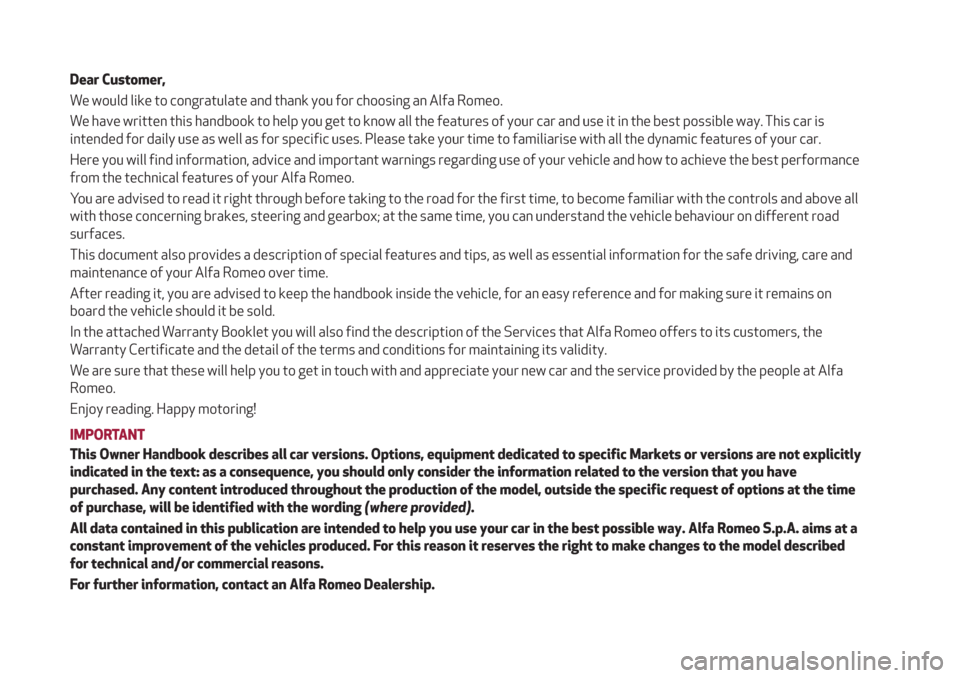
Dear Customer,
We would like to congratulate and thank you for choosing an Alfa Romeo.
We have written this handbook to help you get to know all the features of your car and use it in the best possible way. This car is
intended for daily use as well as for specific uses. Please take your time to familiarise with all the dynamic features of your car.
Here you will find information, advice and important warnings regarding use of your vehicle and how to achieve the best performance
from the technical features of your Alfa Romeo.
You are advised to read it right through before taking to the road for the first time, to become familiar with the controls and above all
with those concerning brakes, steering and gearbox; at the same time, you can understand the vehicle behaviour on different road
surfaces.
This document also provides a description of special features and tips, as well as essential information for the safe driving, care and
maintenance of your Alfa Romeo over time.
After reading it, you are advised to keep the handbook inside the vehicle, for an easy reference and for making sure it remains on
board the vehicle should it be sold.
In the attached Warranty Booklet you will also find the description of the Services that Alfa Romeo offers to its customers, the
Warranty Certificate and the detail of the terms and conditions for maintaining its validity.
We are sure that these will help you to get in touch with and appreciate your new car and the service provided by the people at Alfa
Romeo.
Enjoy reading. Happy motoring!
IMPORTANT
This Owner Handbook describes all car versions. Options, equipment dedicated to specific Markets or versions are not explicitly
indicated in the text: as a consequence, you should only consider the information related to the version that you have
purchased. Any content introduced throughout the production of the model, outside the specific request of options at the time
of purchase, will be identified with the wording(where provided).
All data contained in this publication are intended to help you use your car in the best possible way. Alfa Romeo S.p.A. aims at a
constant improvement of the vehicles produced. For this reason it reserves the right to make changes to the model described
for technical and/or commercial reasons.
For further information, contact an Alfa Romeo Dealership.
Page 9 of 232
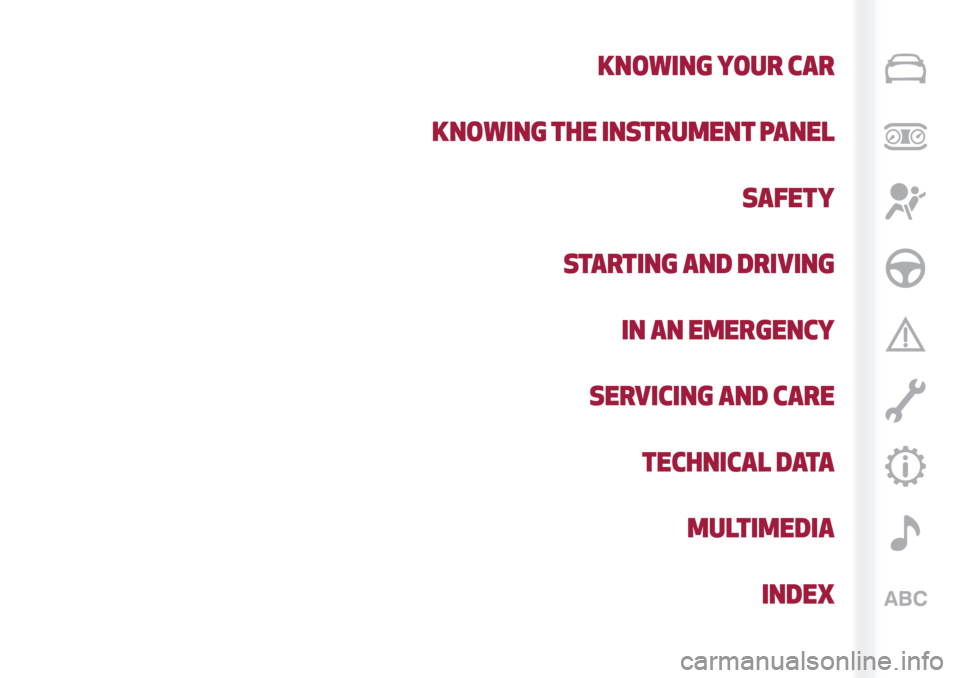
KNOWING YOUR CAR
KNOWING THE INSTRUMENT PANEL
SAFETY
STARTING AND DRIVING
IN AN EMERGENCY
SERVICING AND CARE
TECHNICAL DATA
MULTIMEDIA
INDEX
Page 56 of 232
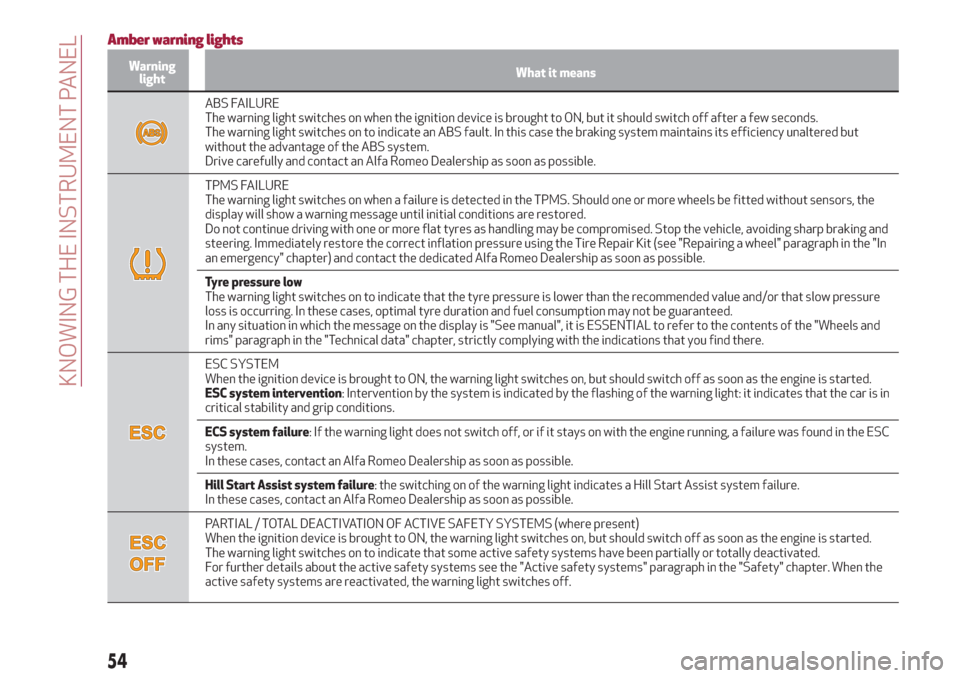
Amber warning lights
Warning
lightWhat it means
ABS FAILURE
The warning light switches on when the ignition device is brought to ON, but it should switch off after a few seconds.
The warning light switches on to indicate an ABS fault. In this case the braking system maintains its efficiency unaltered but
without the advantage of the ABS system.
Drive carefully and contact an Alfa Romeo Dealership as soon as possible.
TPMS FAILURE
The warning light switches on when a failure is detected in the TPMS. Should one or more wheels be fitted without sensors, the
display will show a warning message until initial conditions are restored.
Do not continue driving with one or more flat tyres as handling may be compromised. Stop the vehicle, avoiding sharp braking and
steering. Immediately restore the correct inflation pressure using the Tire Repair Kit (see "Repairing a wheel" paragraph in the "In
an emergency" chapter) and contact the dedicated Alfa Romeo Dealership as soon as possible.
Tyre pressure low
The warning light switches on to indicate that the tyre pressure is lower than the recommended value and/or that slow pressure
loss is occurring. In these cases, optimal tyre duration and fuel consumption may not be guaranteed.
In any situation in which the message on the display is "See manual", it is ESSENTIAL to refer to the contents of the "Wheels and
rims" paragraph in the "Technical data" chapter, strictly complying with the indications that you find there.
ESC SYSTEM
When the ignition device is brought to ON, the warning light switches on, but should switch off as soon as the engine is started.
ESC system intervention: Intervention by the system is indicated by the flashing of the warning light: it indicates that the car is in
critical stability and grip conditions.
ECS system failure: If the warning light does not switch off, or if it stays on with the engine running, a failure was found in the ESC
system.
In these cases, contact an Alfa Romeo Dealership as soon as possible.
Hill Start Assist system failure: the switching on of the warning light indicates a Hill Start Assist system failure.
In these cases, contact an Alfa Romeo Dealership as soon as possible.
PARTIAL / TOTAL DEACTIVATION OF ACTIVE SAFETY SYSTEMS (where present)
When the ignition device is brought to ON, the warning light switches on, but should switch off as soon as the engine is started.
The warning light switches on to indicate that some active safety systems have been partially or totally deactivated.
For further details about the active safety systems see the "Active safety systems" paragraph in the "Safety" chapter. When the
active safety systems are reactivated, the warning light switches off.
54
KNOWING THE INSTRUMENT PANEL
Page 84 of 232
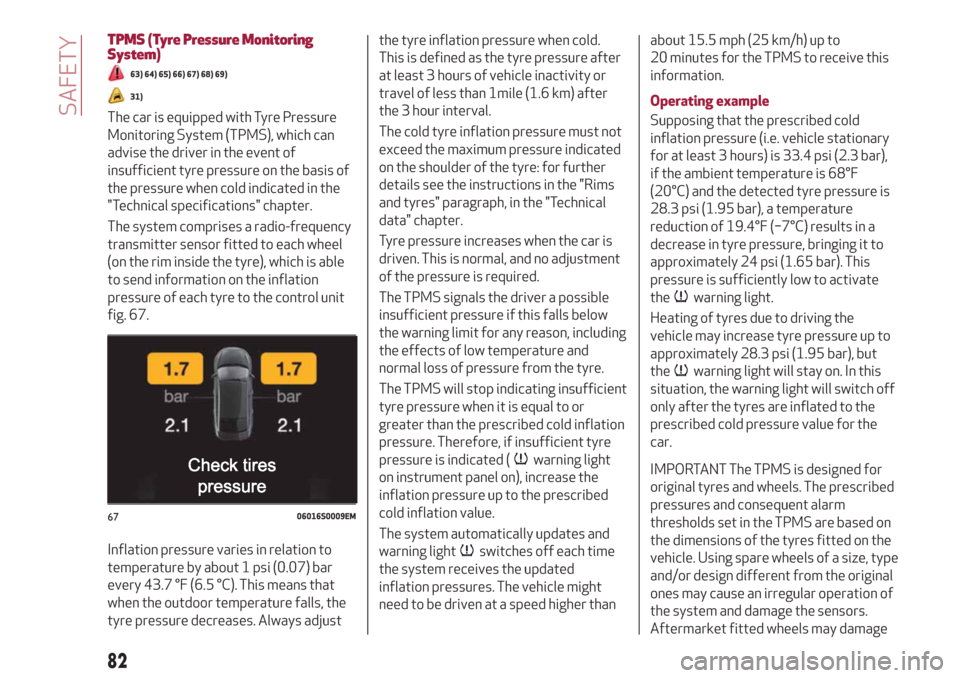
TPMS (Tyre Pressure Monitoring
System)
63) 64) 65) 66) 67) 68) 69)
31)
The car is equipped with Tyre Pressure
Monitoring System (TPMS), which can
advise the driver in the event of
insufficient tyre pressure on the basis of
the pressure when cold indicated in the
"Technical specifications" chapter.
The system comprises a radio-frequency
transmitter sensor fitted to each wheel
(on the rim inside the tyre), which is able
to send information on the inflation
pressure of each tyre to the control unit
fig. 67.
Inflation pressure varies in relation to
temperature by about 1 psi (0.07) bar
every 43.7 °F (6.5 °C). This means that
when the outdoor temperature falls, the
tyre pressure decreases. Always adjustthe tyre inflation pressure when cold.
This is defined as the tyre pressure after
at least 3 hours of vehicle inactivity or
travel of less than 1mile (1.6 km) after
the 3 hour interval.
The cold tyre inflation pressure must not
exceed the maximum pressure indicated
on the shoulder of the tyre: for further
details see the instructions in the "Rims
and tyres" paragraph, in the "Technical
data" chapter.
Tyre pressure increases when the car is
driven. This is normal, and no adjustment
of the pressure is required.
The TPMS signals the driver a possible
insufficient pressure if this falls below
the warning limit for any reason, including
the effects of low temperature and
normal loss of pressure from the tyre.
The TPMS will stop indicating insufficient
tyre pressure when it is equal to or
greater than the prescribed cold inflation
pressure. Therefore, if insufficient tyre
pressure is indicated (
warning light
on instrument panel on), increase the
inflation pressure up to the prescribed
cold inflation value.
The system automatically updates and
warning light
switches off each time
the system receives the updated
inflation pressures. The vehicle might
need to be driven at a speed higher thanabout 15.5 mph (25 km/h) up to
20 minutes for the TPMS to receive this
information.
Operating example
Supposing that the prescribed cold
inflation pressure (i.e. vehicle stationary
for at least 3 hours) is 33.4 psi (2.3 bar),
if the ambient temperature is 68°F
(20°C) and the detected tyre pressure is
28.3 psi (1.95 bar), a temperature
reduction of 19.4°F (−7°C) results in a
decrease in tyre pressure, bringing it to
approximately 24 psi (1.65 bar). This
pressure is sufficiently low to activate
the
warning light.
Heating of tyres due to driving the
vehicle may increase tyre pressure up to
approximately 28.3 psi (1.95 bar), but
the
warning light will stay on. In this
situation, the warning light will switch off
only after the tyres are inflated to the
prescribed cold pressure value for the
car.
IMPORTANT The TPMS is designed for
original tyres and wheels. The prescribed
pressures and consequent alarm
thresholds set in the TPMS are based on
the dimensions of the tyres fitted on the
vehicle. Using spare wheels of a size, type
and/or design different from the original
ones may cause an irregular operation of
the system and damage the sensors.
Aftermarket fitted wheels may damage
6706016S0009EM
82
SAFETY
Page 154 of 232
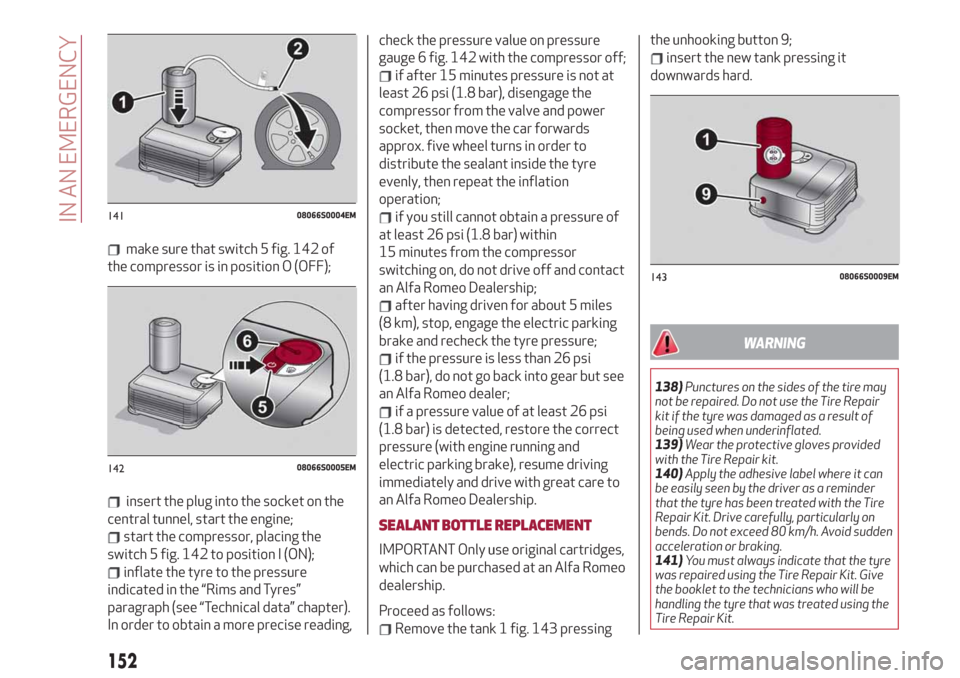
make sure that switch 5 fig. 142 of
the compressor is in position O (OFF);
insert the plug into the socket on the
central tunnel, start the engine;
start the compressor, placing the
switch 5 fig. 142 to position I (ON);
inflate the tyre to the pressure
indicated in the “Rims and Tyres”
paragraph (see “Technical data” chapter).
In order to obtain a more precise reading,check the pressure value on pressure
gauge 6 fig. 142 with the compressor off;
if after 15 minutes pressure is not at
least 26 psi (1.8 bar), disengage the
compressor from the valve and power
socket, then move the car forwards
approx. five wheel turns in order to
distribute the sealant inside the tyre
evenly, then repeat the inflation
operation;
if you still cannot obtain a pressure of
at least 26 psi (1.8 bar) within
15 minutes from the compressor
switching on, do not drive off and contact
an Alfa Romeo Dealership;
after having driven for about 5 miles
(8 km), stop, engage the electric parking
brake and recheck the tyre pressure;
if the pressure is less than 26 psi
(1.8 bar), do not go back into gear but see
an Alfa Romeo dealer;
if a pressure value of at least 26 psi
(1.8 bar) is detected, restore the correct
pressure (with engine running and
electric parking brake), resume driving
immediately and drive with great care to
an Alfa Romeo Dealership.
SEALANT BOTTLE REPLACEMENT
IMPORTANT Only use original cartridges,
which can be purchased at an Alfa Romeo
dealership.
Proceed as follows:
Remove the tank 1 fig. 143 pressingthe unhooking button 9;
insert the new tank pressing it
downwards hard.
WARNING
138)Punctures on the sides of the tire may
not be repaired. Do not use the Tire Repair
kit if the tyre was damaged as a result of
being used when underinflated.
139)Wear the protective gloves provided
with the Tire Repair kit.
140)Apply the adhesive label where it can
be easily seen by the driver as a reminder
that the tyre has been treated with the Tire
Repair Kit. Drive carefully, particularly on
bends. Do not exceed 80 km/h. Avoid sudden
acceleration or braking.
141)You must always indicate that the tyre
was repaired using the Tire Repair Kit. Give
the booklet to the technicians who will be
handling the tyre that was treated using the
Tire Repair Kit.
14108066S0004EM
14208066S0005EM
14308066S0009EM
152
IN AN EMERGENCY
Page 183 of 232
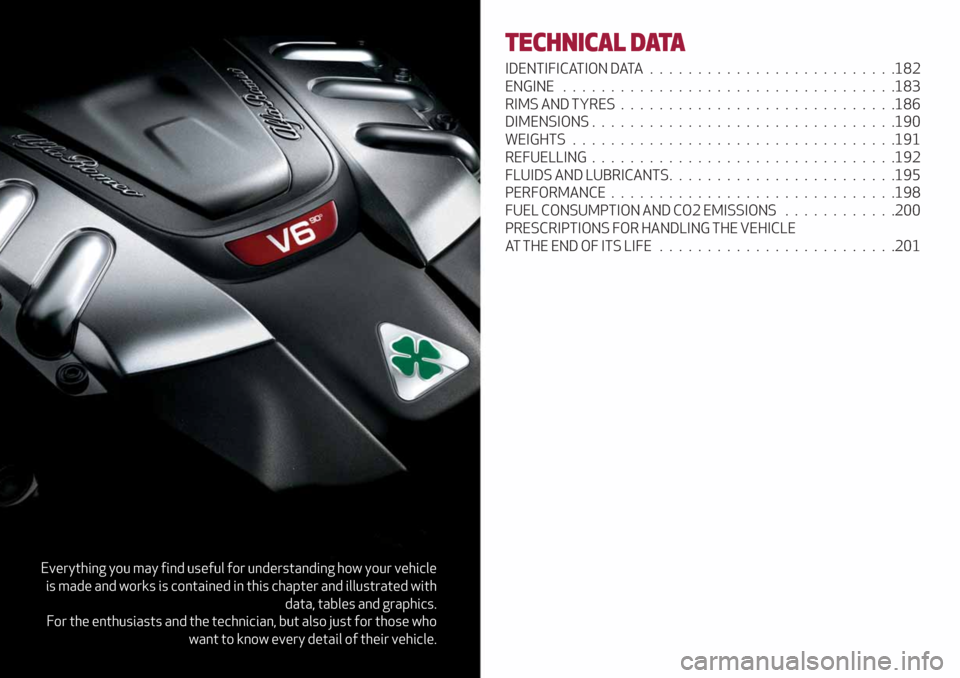
Everything you may find useful for understanding how your vehicle
is made and works is contained in this chapter and illustrated with
data, tables and graphics.
For the enthusiasts and the technician, but also just for those who
want to know every detail of their vehicle.
TECHNICAL DATA
IDENTIFICATION DATA..........................182
ENGINE...................................183
RIMS AND TYRES.............................186
DIMENSIONS . . ..............................190
WEIGHTS..................................191
REFUELLING................................192
FLUIDS AND LUBRICANTS........................195
PERFORMANCE..............................198
FUEL CONSUMPTION AND CO2 EMISSIONS . . ..........200
PRESCRIPTIONS FOR HANDLING THE VEHICLE
AT THE END OF ITS LIFE.........................201
Page 184 of 232
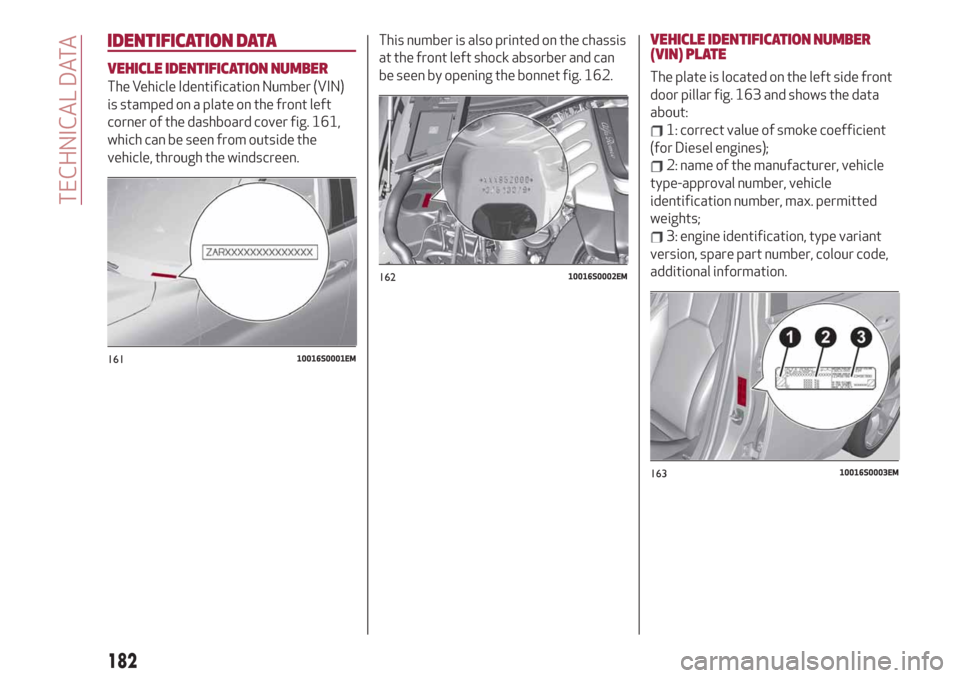
IDENTIFICATION DATA
VEHICLE IDENTIFICATION NUMBER
The Vehicle Identification Number (VIN)
is stamped on a plate on the front left
corner of the dashboard cover fig. 161,
which can be seen from outside the
vehicle, through the windscreen.This number is also printed on the chassis
at the front left shock absorber and can
be seen by opening the bonnet fig. 162.
VEHICLE IDENTIFICATION NUMBER
(VIN) PLATE
The plate is located on the left side front
door pillar fig. 163 and shows the data
about:
1: correct value of smoke coefficient
(for Diesel engines);
2: name of the manufacturer, vehicle
type-approval number, vehicle
identification number, max. permitted
weights;
3: engine identification, type variant
version, spare part number, colour code,
additional information.
16110016S0001EM
16210016S0002EM
16310016S0003EM
182
TECHNICAL DATA
Page 186 of 232
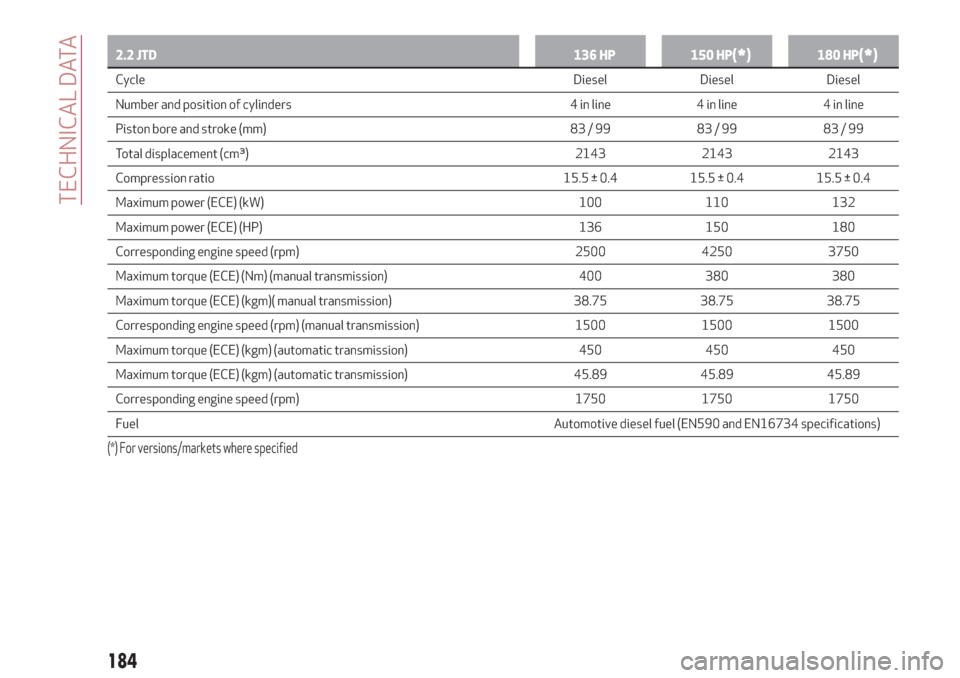
2.2 JTD136 HP 150 HP(*)180 HP(*)
CycleDiesel Diesel Diesel
Number and position of cylinders 4 in line 4 in line 4 in line
Piston bore and stroke (mm) 83 / 99 83 / 99 83 / 99
Total displacement (cm³) 2143 2143 2143
Compression ratio 15.5 ± 0.4 15.5 ± 0.4 15.5 ± 0.4
Maximum power (ECE) (kW) 100 110 132
Maximum power (ECE) (HP) 136 150 180
Corresponding engine speed (rpm) 2500 4250 3750
Maximum torque (ECE) (Nm) (manual transmission) 400 380 380
Maximum torque (ECE) (kgm)( manual transmission) 38.75 38.75 38.75
Corresponding engine speed (rpm) (manual transmission) 1500 1500 1500
Maximum torque (ECE) (kgm) (automatic transmission) 450 450 450
Maximum torque (ECE) (kgm) (automatic transmission) 45.89 45.89 45.89
Corresponding engine speed (rpm) 1750 1750 1750
FuelAutomotive diesel fuel (EN590 and EN16734 specifications)
(*) For versions/markets where specified
184
TECHNICAL DATA
Page 188 of 232
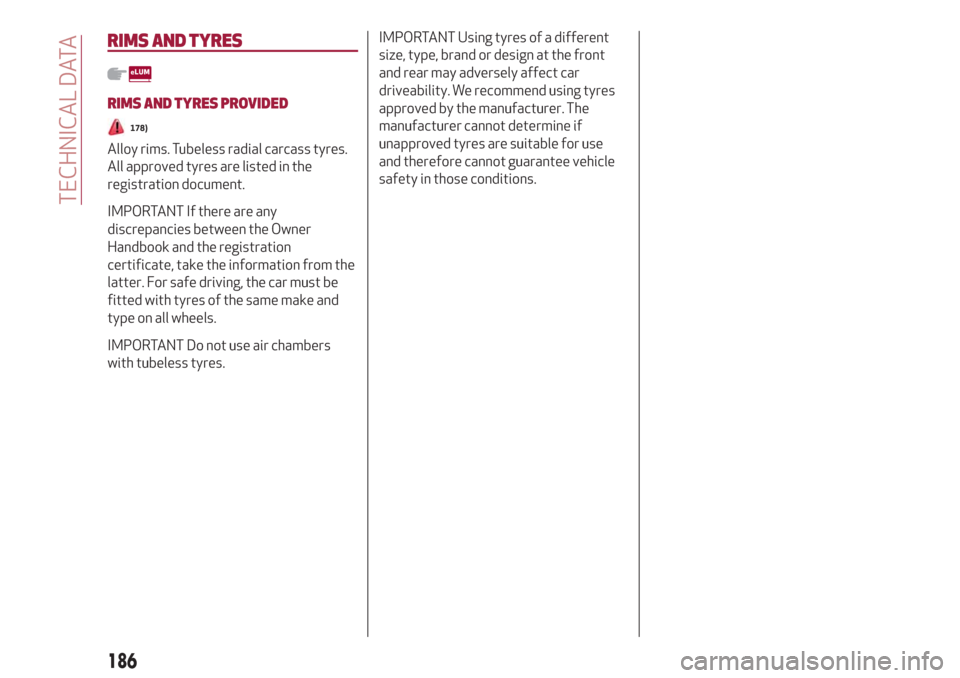
RIMS AND TYRES
RIMS AND TYRES PROVIDED
178)
Alloy rims. Tubeless radial carcass tyres.
All approved tyres are listed in the
registration document.
IMPORTANT If there are any
discrepancies between the Owner
Handbook and the registration
certificate, take the information from the
latter. For safe driving, the car must be
fitted with tyres of the same make and
type on all wheels.
IMPORTANT Do not use air chambers
with tubeless tyres.IMPORTANT Using tyres of a different
size, type, brand or design at the front
and rear may adversely affect car
driveability. We recommend using tyres
approved by the manufacturer. The
manufacturer cannot determine if
unapproved tyres are suitable for use
and therefore cannot guarantee vehicle
safety in those conditions.
186
TECHNICAL DATA
Page 190 of 232
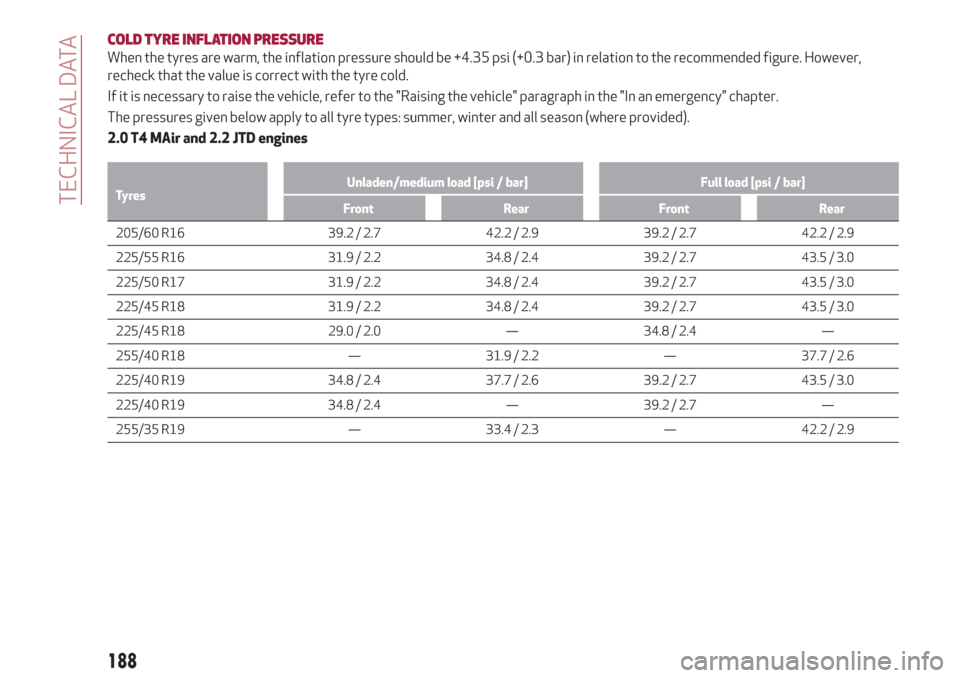
COLD TYRE INFLATION PRESSURE
When the tyres are warm, the inflation pressure should be +4.35 psi (+0.3 bar) in relation to the recommended figure. However,
recheck that the value is correct with the tyre cold.
If it is necessary to raise the vehicle, refer to the "Raising the vehicle" paragraph in the "In an emergency" chapter.
The pressures given below apply to all tyre types: summer, winter and all season (where provided).
2.0 T4 MAir and 2.2 JTD engines
TyresUnladen/medium load [psi / bar] Full load [psi / bar]
Front Rear Front Rear
205/60 R16 39.2 / 2.7 42.2 / 2.9 39.2 / 2.7 42.2 / 2.9
225/55
R16 31.9 / 2.2 34.8 / 2.4 39.2 / 2.7 43.5 / 3.0
225/50 R17 31.9 / 2.2 34.8 / 2.4 39.2 / 2.7 43.5 / 3.0
225/45 R18 31.9 / 2.2 34.8 / 2.4 39.2 / 2.7 43.5 / 3.0
225/45 R18 29.0 / 2.0 — 34.8 / 2.4 —
255/40 R18 — 31.9 / 2.2 — 37.7 / 2.6
225/40 R19 34.8 / 2.4 37.7 / 2.6 39.2 / 2.7 43.5 / 3.0
225/40 R19 34.8 / 2.4 — 39.2 / 2.7 —
255/35 R19 — 33.4 / 2.3 — 42.2 / 2.9
188
TECHNICAL DATA